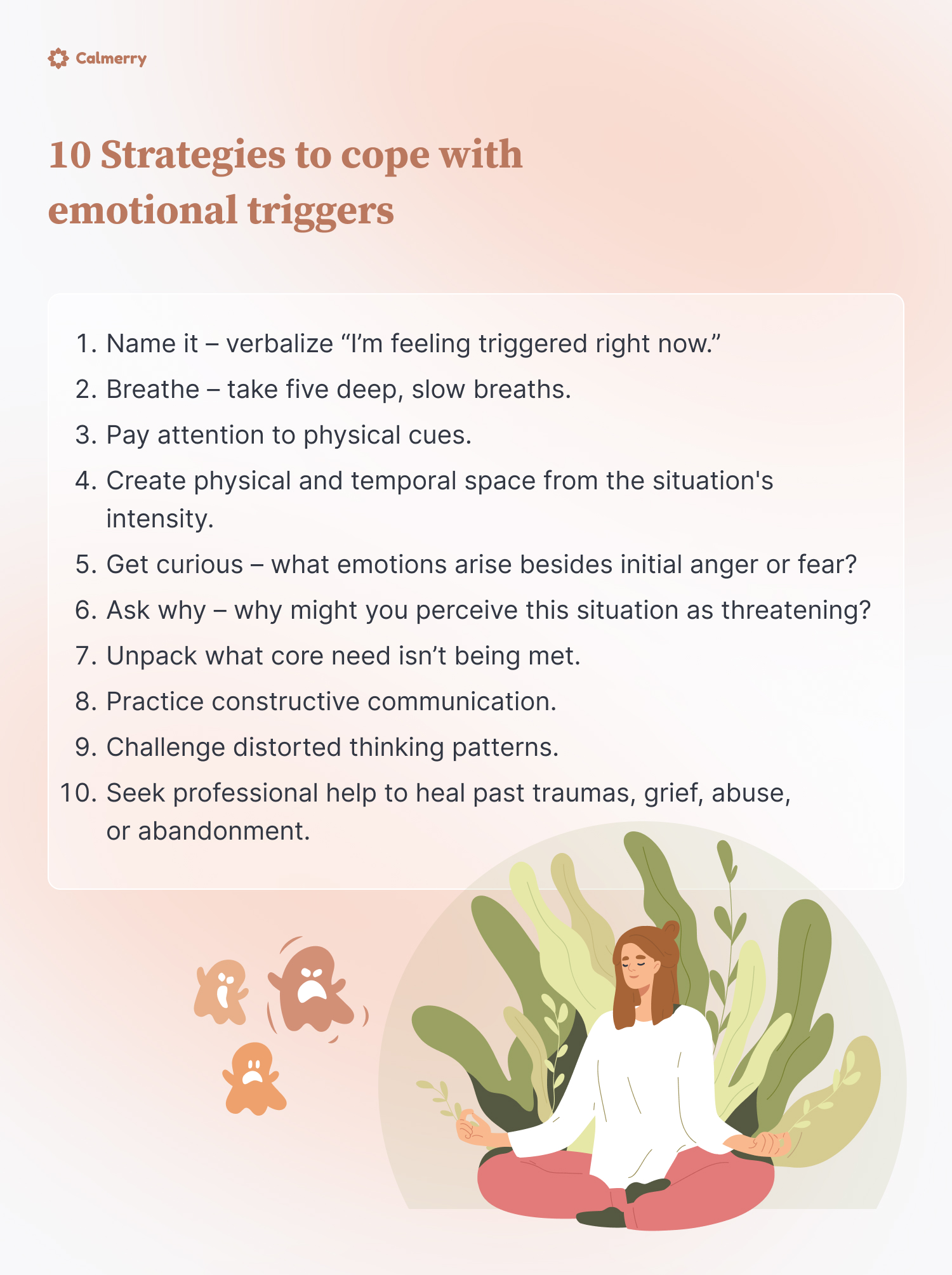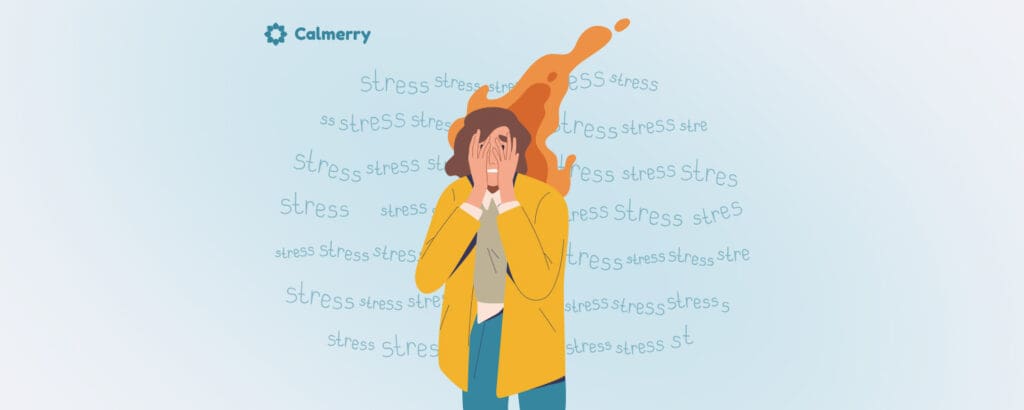Decoding Emotional Triggers: A Guide to Responding, Not Reacting

In this article
Do you ever feel completely hijacked by your emotions over something seemingly small – a single comment, noise, or just a rush of thoughts? Heart pounding, face flushed from a wave of anger, hurt, or fear.
In that moment, it’s as if you lose control, only to later regret those reactive impulses.
We all have emotional triggers – sensitive buttons that spark immediate, intense reactions when pressed. Often stemming from past trauma, triggers unleash stress hormones before logic intervenes. Learning to defuse these reactions is essential for relationships and well-being.
This article explains emotional triggers through a science lens while providing techniques to respond thoughtfully, not reflexively, when activated. With practice, we can prevent harm to ourselves and others in hot moments.
What are emotional triggers?
Emotional triggers are stimuli that spark a significant emotional response. They press on sensitive areas connected to past experiences or deeply held beliefs unique to each of us.
Reactions differ from person to person, shaped profoundly by our individual histories and psychological frameworks. Understanding emotional triggers is crucial for gaining control over our emotions and nurturing mental well-being.
It’s important to acknowledge that experiencing emotional triggers is a universal human experience. With our complex psyches conditioned by prior experiences, triggers are unavoidable and can feel intensely painful when activated.
There is no shame in finding certain situations or interactions profoundly triggering. This pain and intensity are valid – you are heard and not alone.
– Dr. Mona Kirstein, Certified holistic coach and consultant
Examples of emotional triggers
Emotional triggers manifest our deepest sensitivities and historical pains. When activated, they trigger intense emotions that feel blown out of proportion compared to the actual stimulus.
Some common triggers include:
Rejection
Those are the moments of perceived disapproval, like an averted glance or curt message, can spark intense feelings of anxiety, hurt, or sadness. This emotional reaction emerges from those familiar with rejection’s painful sting.
Abandonment
Individuals who have experienced childhood abandonment wounds may feel intense distress. This distress can occur when they are excluded or left alone. These experiences can bring back painful memories of trauma.
Success and failure
Situations that mirror positive or negative events can bring intense emotions. As a holistic coach and consultant for female entrepreneurs, I’ve seen how even minor failures can unlock overwhelming emotions by exposing deep-seated shame and self-judgment.
For instance, one client felt increasing anxiety and self-doubt after an unsatisfied client left a negative review online. This relatively minor feedback triggered childhood memories of criticism for not excelling academically to impossibly high standards set by her parents.
The intense emotional reaction reflected deeply rooted beliefs from childhood that any feedback signified personal failure as an entrepreneur.
Authority figures
Encounters with authority figures can trigger intense negative emotions. These emotions may include fear, knee-jerk obedience, and childhood resentment.
Sensory cues
Sights, sounds, or smells associated with impactful past moments carry passage to our memories. They can be pleasant or disturbing, but either way, they tap into the emotional remnants living within us.
Sometimes, they even make mental health conditions worse.

What are the root causes of emotional triggers?
You might find yourself wondering, “Why do I get triggered so easily?“. Understanding these root causes is the first step toward better emotional regulation.
Unprocessed adversity often underlies post-traumatic stress disorder. Past traumas resurface unexpectedly. Everyday events subtly echo prior suffering, flooding us with familiar stress before logic steps in.
Experience shapes our sensitivities
The emotional brain associates experiences with feelings through the imprint of memory. Scents suddenly transport us back through time; strained tones tap into emotional triggers, stirring anxiety. Our sensitivities reflect this neural conditioning.
Trauma resonates through triggers
Unprocessed adversity often underlies post-traumatic stress disorder. Past traumas unexpectedly resurface when everyday events subtly echo prior suffering, flooding us with familiar stress before logic intervenes.
Childhood trauma primes overreactions
Childhood adversity, such as abuse, neglect, and caregiver loss, can cause the brain to overreact in the future. These experiences prime the perception of threat, causing an exaggerated response to triggering situations.
Evolution ingrains survival responses
We are inherently primed to use emotions like anger and fear for survival. When chronically activated, the brain adapts by wiring triggers as warnings.
Pain can alter our threat perception
Distressing life events, such as grief or trauma, can alter the brain’s perception of threat. This can lead to new sensitivities and an increased risk of anxiety disorders.
Learned behaviors model reactions
Cultural conditioning can demonstrate and reinforce emotional reactions in us. Family dynamics can also trigger and reinforce emotional reactions in us. Social groups can contribute to our emotional reactions during our formative years.
The brain’s response: the science behind triggers
When a trigger activates, it sparks a complex dance between our emotional and thinking centers rooted deep in the brain’s evolution.
The key players in our brain are the almond-sized amygdala and the prefrontal cortex. The amygdala controls our primal fight-flight response, while the prefrontal cortex is responsible for rational thinking.
The amygdala: the epicenter of trigger reactions
Brain scans reveal that the amygdala responds strongly to emotional stimuli. [1] Diano, M., Celeghin, A., Bagnis, A., & Tamietto, M. (2017). Amygdala Response to Emotional Stimuli without Awareness: Facts and Interpretations. Frontiers in Psychology, 7. https://doi.org/10.3389/fpsyg.2016.02029 These stimuli can be positive or negative, and the intensity and relevance of the stimuli play a role in this response.
The amygdala’s reaction is based on these factors rather than the actual feeling they evoke. This demonstrates why even upsetting triggers provoke stronger reactions than muted positive ones.
Prefrontal cortex: rational break failure
The prefrontal cortex normally applies logic and reason. However, it often goes offline temporarily when the amygdala signals a threat. This allows emergency reactions to take over. This explains the feeling of losing rational control during heated arguments.
Impact on decision-making
The amygdala signals high alarm, causing our prefrontal cortex to temporarily shut down. This allows us to react quickly based on emotion rather than reason. Repeated triggering amplifies this reactive pathway’s strength.
Retraining our reactions
Fortunately, the brain’s adaptive “plasticity” allows for rewiring. [2] Giuliani, N. R., Drabant, E. M., Bhatnagar, R., & Gross, J. J. (2011). Emotion regulation and brain plasticity: Expressive suppression use predicts anterior insula volume. NeuroImage, 58(1), 10–15. https://doi.org/10.1016/j.neuroimage.2011.06.028 Consistently responding mindfully to triggers can dampen their sensitivity.
Just like walking a trail, this entrenches the response over time. As we wonder, “Do emotional triggers ever go away?” – they may not vanish entirely, but their intensity and influence prove malleable through diligent practice.
Mindfulness: taking power back from triggers
Mindfulness provides techniques for decompressing reactions caused by strong emotions. According to numerous studies, mindfulness practices stimulating present-moment non-judgmental awareness lead to improved regulation of emotional reactivity and impulses.
[3]
Guendelman, S., Medeiros, S., & Rampes, H. (2017). Mindfulness and Emotion Regulation: Insights from Neurobiological, Psychological, and Clinical Studies. Frontiers in Psychology, 8. https://doi.org/10.3389/fpsyg.2017.00220
These techniques promote self-awareness and self-control. Instead of being victims of knee-jerk responses, we can develop coping skills and train ourselves to respond thoughtfully.
Techniques for mindful emotion regulation
- Observe physical sensations – scan your body to identify where you feel muscle tension, heart pounding, or other physical signs of high emotion. Connecting sensations grounds you in the present.
- Notice thought patterns – tune into the self-talk fueling distress. Attachment to reactionary narratives only feeds the flames.
- Practice refocusing attention – acknowledge feelings without getting wrapped up in their storyline. Then, purposefully shift attention to external sensory details unrelated to the internal cascade.
Using these mindfulness techniques shows how to deal with triggers in a healthy way.
By developing mindfulness around strong emotional responses, we can short-circuit reactive habits and respond thoughtfully based on our values, even when triggered.
– Dr. Mona Kirstein, Certified holistic coach and consultant
The above practices build awareness in the moment so we can consciously choose regulation over overreaction.
How to decode your trigger’s message
Triggers reveal our emotions behind anger, attachment style, and unmet needs. But their message can arrive wrapped in painful emotional static. Learning to decode the signal beneath the noise is essential to managing emotional triggers.
- Pay attention to physical cues – does your heart race? Does your body feel tense? These suggest an emotional threat response is activated.
- Get curious – what emotions arise besides initial anger or fear? Triggers often mask more vulnerable emotions like hurt, grief, shame, or loneliness.
- Ask why – why might you perceive this situation as threatening? Was a personal boundary crossed? Does it connect to a past traumatic experience? Looking for root causes diffuses intensity.
- Consider context – is the person aware this is sensitive for you? Can you perceive positive intent, even if the impact was negative? Understanding context helps reframe automatic threat perception.
- Unpack the need – what core need isn’t being met? Feelings like anger often point to the need for respect or security. Identifying these helps communicate in a healthy way.
7 Strategies for reframing triggered reactions
When triggers arise, it’s important to create space for calmness. This helps us respond thoughtfully and handle triggers skillfully.
1. Grounding strategies to stay present
When your emotions become overwhelming, use grounding practices to stay present. These practices will help you remain anchored.
- Name it – verbalize “I’m feeling triggered right now.”
- Breathe – take five deep, slow breaths
- Get space – step away until your rational mind comes fully back online
2. Reframing your reaction
You can reduce the impact of triggered reactions by consciously reframing tension as opportunities for mutual understanding and growth using affirmations and deep breathing.
This transforms conflict into a healing connection for you. Actively managing emotional triggers in this way minimizes their power over you.
3. Practice constructive communication
When emotions run high, it’s essential to communicate in a productive way. Once you feel more centered, try these strategies:
- Start by validating any common ground. Then, express your own perspective using “I feel” phrases. This reduces defensiveness.
- Aim for win-win solutions that align with shared goals. This prevents unproductive clashes.
- Ask questions to clarify each other’s viewpoints and ensure mutual understanding.
- Take ownership of your contributions to the situation without pointing fingers. This diffuses tension.
These healthy communication strategies provide guidance for “how to communicate when you’re triggered.” Practicing them facilitates thoughtful connection during difficult moments.
4. Learn from each incident
After tensions cool post-conflict, take time to collaboratively discuss and record what communication methods worked well and why unhelpful approaches backfired.
Researchers link this process with improved harmony by applying lessons learned about positive dialoguing.
5. Give yourself time and space
Creating physical and temporal space from the situation’s intensity can become vital when you feel triggered. It disengages you from the physiological arousal catalyzing fight or flight reactivity.
Removing yourself could involve:
- Simply exiting the room.
- Postponing a charged conversation.
- Going for a walk to clear your head.
- Even calling in sick from work after an overwhelming incident.
Prioritizing self-care first builds resilience when managing triggers.
6. Challenge distorted thinking patterns
Our inner narratives often misrepresent reality when overwhelmed by difficult emotions. Ask yourself – is there evidence this worst-case scenario is accurate? What would someone else say about this situation more objectively?
Actively counterargument distorted thoughts.
7. Seek professional help when needed
While daily mindfulness helps manage reactions in the moment, some emotional triggers run very deep. Healing past traumas, grief, abuse, or abandonment often requires working with mental health professionals, either in person or through online therapy on Calmerry.
There is no shame in asking for help – it’s an act of courage and self-care. Counseling can also help you develop skills for managing emotional responses that feel overwhelming on your own.
– Dr. Mona Kirstein, Certified holistic coach and consultant
Managing triggers by rewiring your responses
While emotional triggers may initially feel automatic, you have the power to cultivate skills over time to respond thoughtfully instead of reacting reflexively when those buttons get pressed.
Crucially, it helps to continually ask “How do I stop emotionally reacting?” Applying strategies rooted in mindfulness, communication techniques, and deeper self-awareness equips you to rewire those threat response patterns that hijack your reactions.
Creating physical and emotional space when flooded also proves vital.
Over time and with practice, you can get to a place where you more often respond constructively rather than reactively when your emotional vulnerabilities are exposed. Have hope and compassion for yourself along the way.
Diano, M., Celeghin, A., Bagnis, A., & Tamietto, M. (2017). Amygdala Response to Emotional Stimuli without Awareness: Facts and Interpretations. Frontiers in Psychology, 7. https://doi.org/10.3389/fpsyg.2016.02029
Giuliani, N. R., Drabant, E. M., Bhatnagar, R., & Gross, J. J. (2011). Emotion regulation and brain plasticity: Expressive suppression use predicts anterior insula volume. NeuroImage, 58(1), 10–15. https://doi.org/10.1016/j.neuroimage.2011.06.028
Guendelman, S., Medeiros, S., & Rampes, H. (2017). Mindfulness and Emotion Regulation: Insights from Neurobiological, Psychological, and Clinical Studies. Frontiers in Psychology, 8. https://doi.org/10.3389/fpsyg.2017.00220
online therapy
live video session



